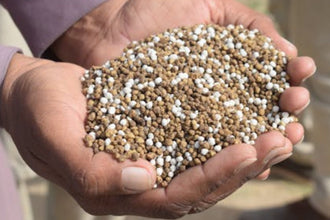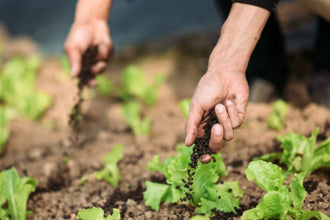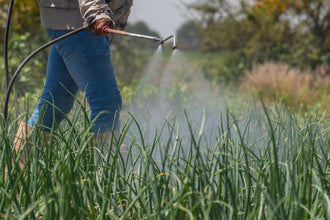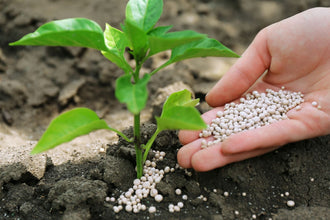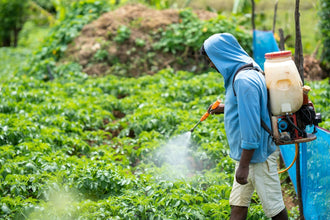Do you often wonder why organic matter-rich soil doesn't yield thriving plants? This blog post aims to demystify why soil full of organic matter might only sometimes be fertile.
We'll explore the essential factors of soil fertility and the intricate balance between organic matter, minerals, and soil's water retention capability. By the end, we will debunk some common myths associated with organic matter and soil fertility and offer tips for improving the productivity of your organic matter-rich soils. Understanding soil fertility can be tricky, but it's essential for achieving bountiful harvests in your garden or farm.
Understanding Soil Fertility
Soil fertility is how well the soil can support plant growth. It relies on elements like soil texture, nutrient content, and the presence of microorganisms.
Among these, organic matter is key, from decaying plant or animal material. It enriches the soil and helps it hold water and nutrients better. However, it must be balanced. Too much can lead to soil infertility.
Understanding soil fertility involves achieving this balance. We'll explore the role of organic matter and its effects on fertility next.
Why Organic Matter Rich Soils Might Not Be Fertile?
Organic matter is hailed as the lifeblood of healthy soil. It consists of decomposed plant and animal material, which is present in the soil. It plays several significant roles, such as supplying nutrients to plants and enhancing the soil's ability to retain water.
But have you ever pondered that soil rich in organic matter might not necessarily be fertile? Yes, you heard it right! It might be a paradox, but it's a fact we can't deny. Let's delve deeper and untangle this paradox.
The Paradox Explained
The paradox between organic matter richness in the soil and fertility is like a complex puzzle. You might initially think high organic matter content should translate to increased fertility. However, this is only sometimes the case.
The truth is that soil fertility isn't solely determined by the quantity of organic matter in the soil. Various factors are crucial in soil fertility, including mineral balance and water retention ability. A disproportion of these factors might make the soil less fertile despite being rich in organic matter.
The Role of Mineral Nutrient Balance
Mineral nutrients are essential for plant growth. They are critical for building proteins, enzymes, vitamins, and other crucial elements of a plant's physiological activity. An adequate amount of necessary minerals ensures optimal plant growth, leading to soil fertility.
However, even if the soil is rich in organic matter, an imbalance in mineral nutrients can hinder plant growth. Excessive or deficient quantities of certain minerals, such as nitrogen, phosphorus, or potassium, can disrupt the normal physiological processes of plants. Excessive nutrients may lead to soil toxicity, while deficiency can result in plants being malnourished, thereby influencing the fertility status of the soil.
The Impact of Water Retention
Water retention capability is another vital feature of fertile soil. Organic matter improves a soil's water-holding capacity but doesn't necessarily make it productive.
Why so? Here's the catch. Although organic matter aids in retaining water, plants need a suitable water-air ratio in the soil to thrive. If the soil holds too much water (waterlogging) or very little of it (drought), it can adversely affect plant growth, regardless of how rich in organic matter the soil might be.
So, the paradox of organic matter-rich soils being infertile stems from the intricate balance of several factors, such as mineral nutrient balance and water retention capacity. Therefore, a more holistic approach that considers all parameters is essential when assessing soil fertility.
Common Misconceptions about Soil Fertility
Soil fertility is a concept closely associated with several myths and misconceptions. The intricate science behind it often leads to erroneous interpretations and the spread of misconceptions.
One of the biggest myths centers around the role of organic matter and how it influences soil fertility. Let's debunk this myth and shed some light on the reality!
Debunking Myths Related to Organic Matter and Fertility
Let's uncover the truth and bust some common organic matter and soil fertility myths!
Myth 1: Soil Rich in Organic Matter Is Always Fertile
This myth is the most prevailing one. Many believe that high organic matter automatically equates to increased fertility. This false belief has existed for years because organic matter beneficially affects soil properties.
However, the truth is that organic matter is just one piece of the fertility puzzle. Soil fertility depends on balanced mineral nutrients, appropriate pH levels, and optimal water-holding capacity. Thus, while organic matter helps, it does not guarantee a soil's fertility.
Myth 2: More Organic Matter Is Always Better
The assumption that adding more and more organic matter to your soil will make it highly fertile is far from the truth. Unfortunately, you can't simply "overdose" your soil with organic matter and expect thriving plants.
Excessive organic matter can result in imbalances in nutrients. It might even hinder the soil's ability to retain water effectively, leading to poor plant growth. Also, it can create an environment favorable for developing specific pathogens or pests. Remember, balance is the key!
One fundamental truth about soil fertility is that it's not dependent on organic matter alone. Instead, it's a complex and delicate equilibrium of various elements and conditions. So next time, think twice before subscribing to a conventional myth!
Types of Fertile Soil
Different soils can help plants grow in their ways. Here, we break down the three most common types of fertile soil: sandy, clay, and silt. We'll discuss what they are, what makes them fruitful, and what plants like growing in them.
1. Sandy Soil
Sandy soil has big particles and feels loose and gritty to the touch. Because the grains are more significant, water can flow easily, so sandy soil drains fast and doesn't hold water for long. It's rich in potassium and lets oxygen get to plant roots quickly, making it great for plants that don't need a lot of water, like cacti, succulents, and other hardy plants.
2. Clay Soil
Clay soil feels smooth, almost like plastic, when wet. It has tiny particles that pack closely together, so water and nutrients stay in the soil longer. This makes clay soil rich and great for growing plants that need lots of water and nutrients, like tomatoes or sunflowers. But be careful not to overwater your plants because they can become waterlogged and prevent oxygen from reaching the roots.
3. Silt Soil
Silt soil is somewhere between sandy soil and clay soil. It feels soft and soapy. It holds water but also allows for good drainage. It's packed with nutrients and is very fertile, making it the perfect place for most plants to grow. Crops like wheat, fruit trees, and shrubs really like silt soil.
Remember, no soil is perfect. However, knowing your soil type will help you understand what needs to be added to make it right for your plants. Happy planting!
Improving the Fertility of Organic Matter-rich Soils
Do you have soil with lots of organic matter, but your plants don't seem to be thriving? Here, we'll share some practical tips on how to improve the fertility of such soil.
Tip 1: Test Your Soil
Before you try to fix your soil, you should first understand it. Use a soil testing kit to check your soil's nutrient and pH levels. Testing your soil will help you know what needs to be added and what you're getting too much of.
Tip 2: Adjust Your Soil's pH
Soil pH is how acidic or alkaline your soil is. This is important for the health of your plants—most plants like soil pH between 6.0 and 7.0. You can add lime or sulfur if your soil is too acidic or alkaline.
Tip 3: Consider Adding More Minerals
Sometimes, soil rich in organic matter may lack certain minerals. According to your soil test results, you should add more minerals.
Tip 4: Maintain Proper Watering
Too much or too little water can harm your plants. Make sure your soil has good drainage. Also, check your soil regularly to ensure it's not too dry or too wet.
Improving the fertility of organic matter-rich soil is all about balance. If you follow these tips, your soil will be in better shape, and your plants will thank you!
Conclusion
Soil fertility is a complex yet crucial aspect of successful gardening or farming. It's important to remember that while organic matter is beneficial, it's not the only factor contributing to soil fertility. The delicate balance among organic matter, mineral nutrients, and water retention capacity plays a crucial role in dictating the productive potential of your soil.
Busting the myths surrounding soil fertility, especially about organic matter, allows us to manage our soils more effectively. Fostering soil fertility is about maintaining balance and not overloading the soil with excessive organic matter.
Lastly, remember the four practical tips to improve the fertility of your organic matter-rich soil: test your soil, adjust its pH, consider adding more minerals, and manage water properly. With patience, knowledge, and the right approach, your soil can become a fertile haven for your plants to thrive. Happy gardening or farming!




